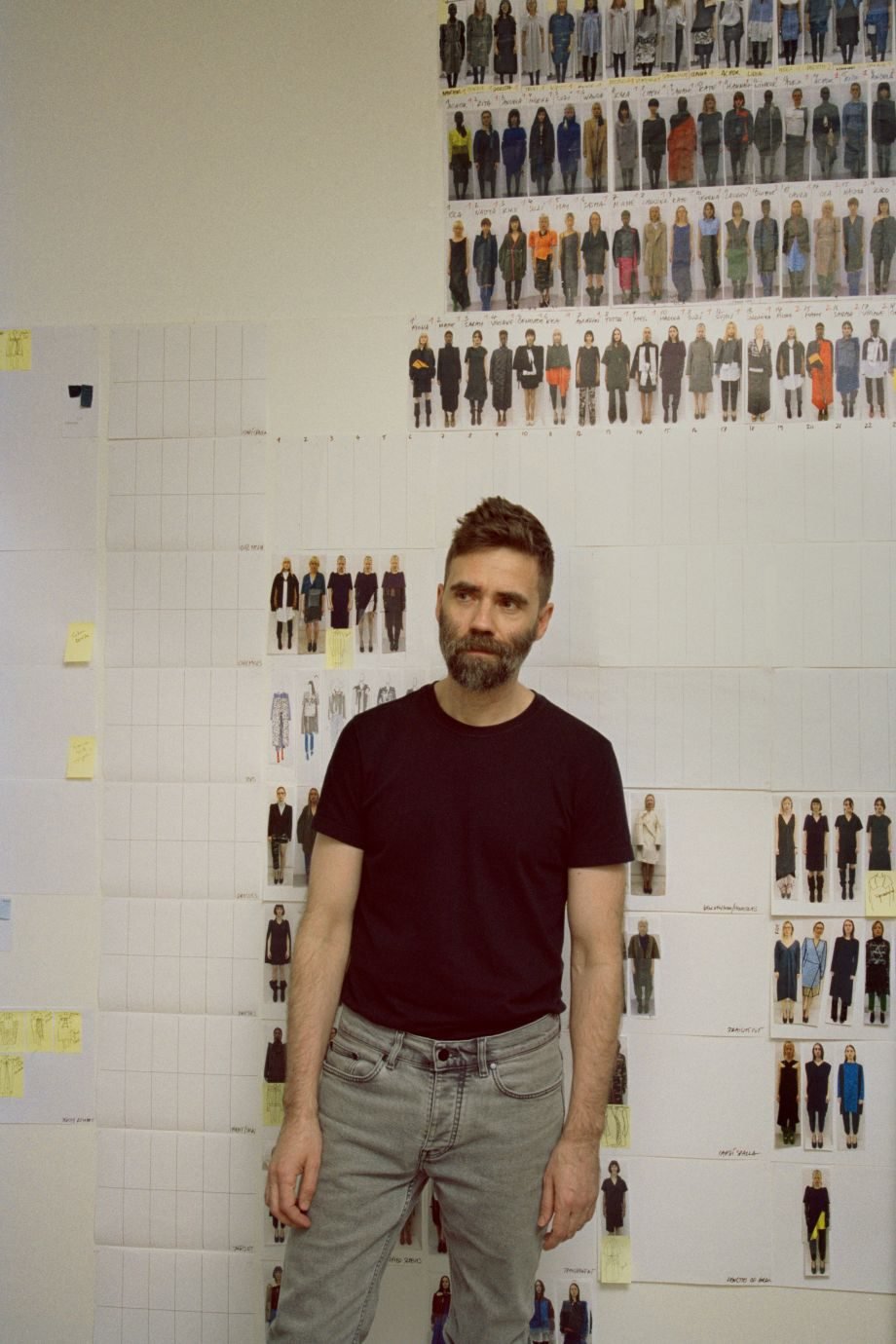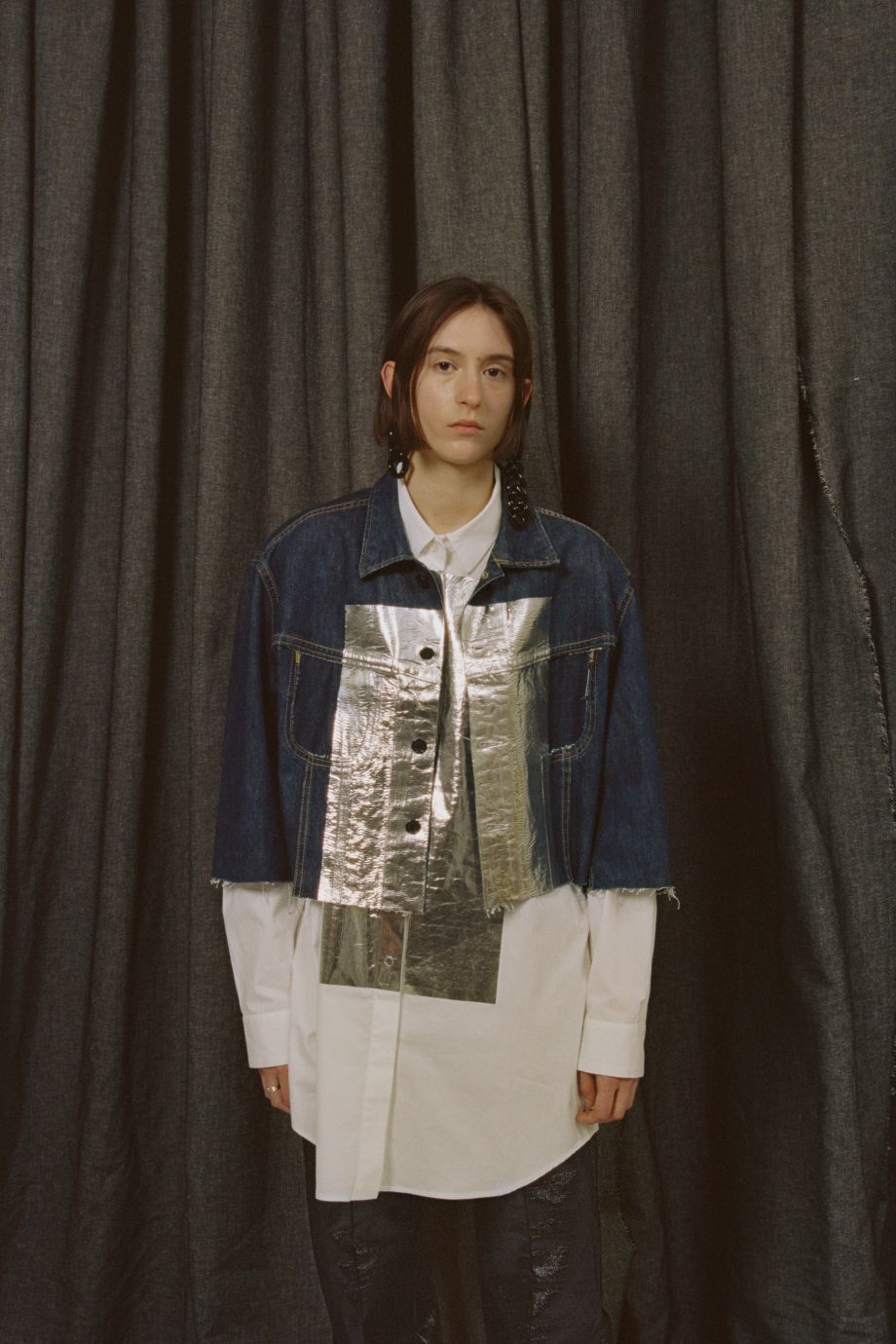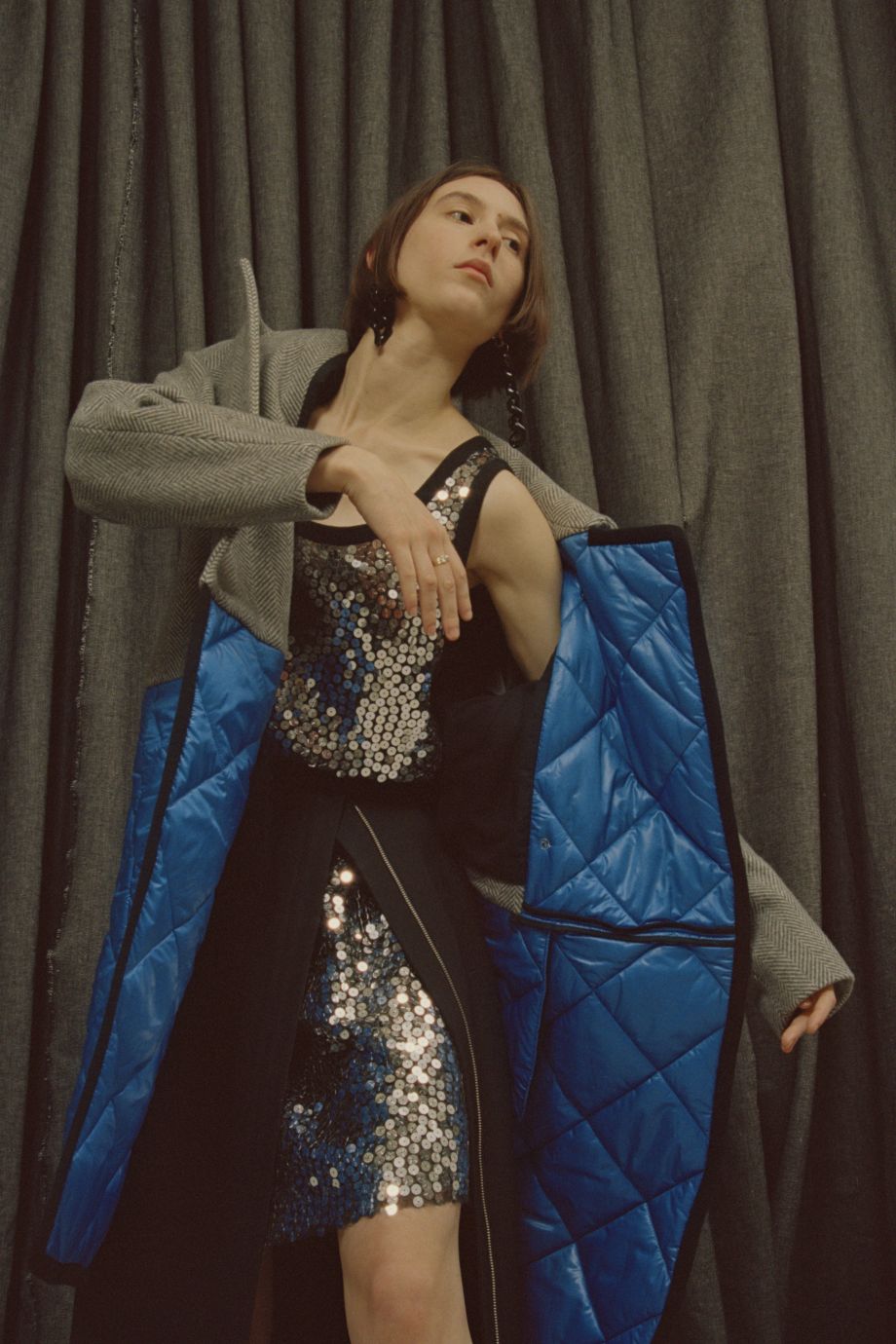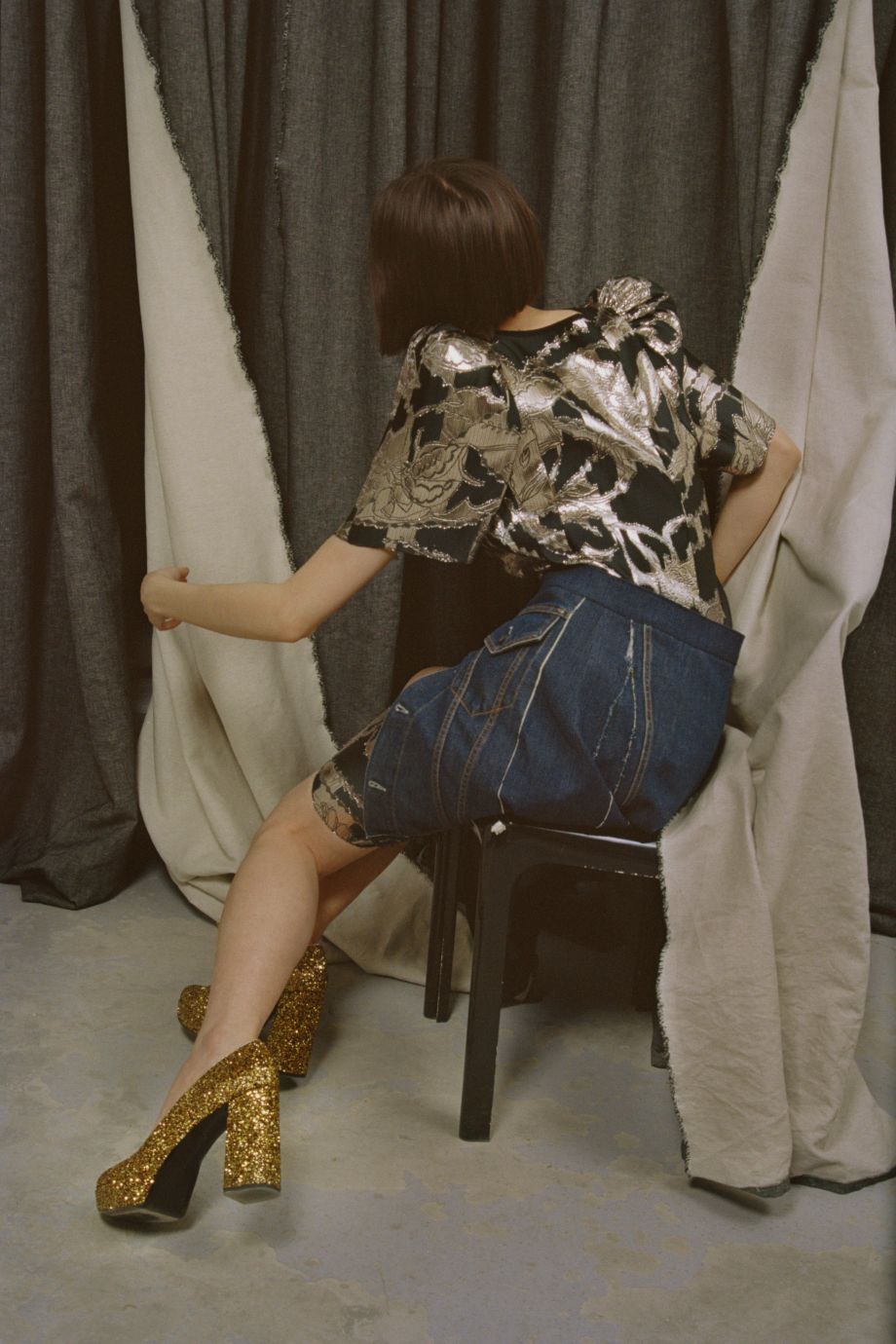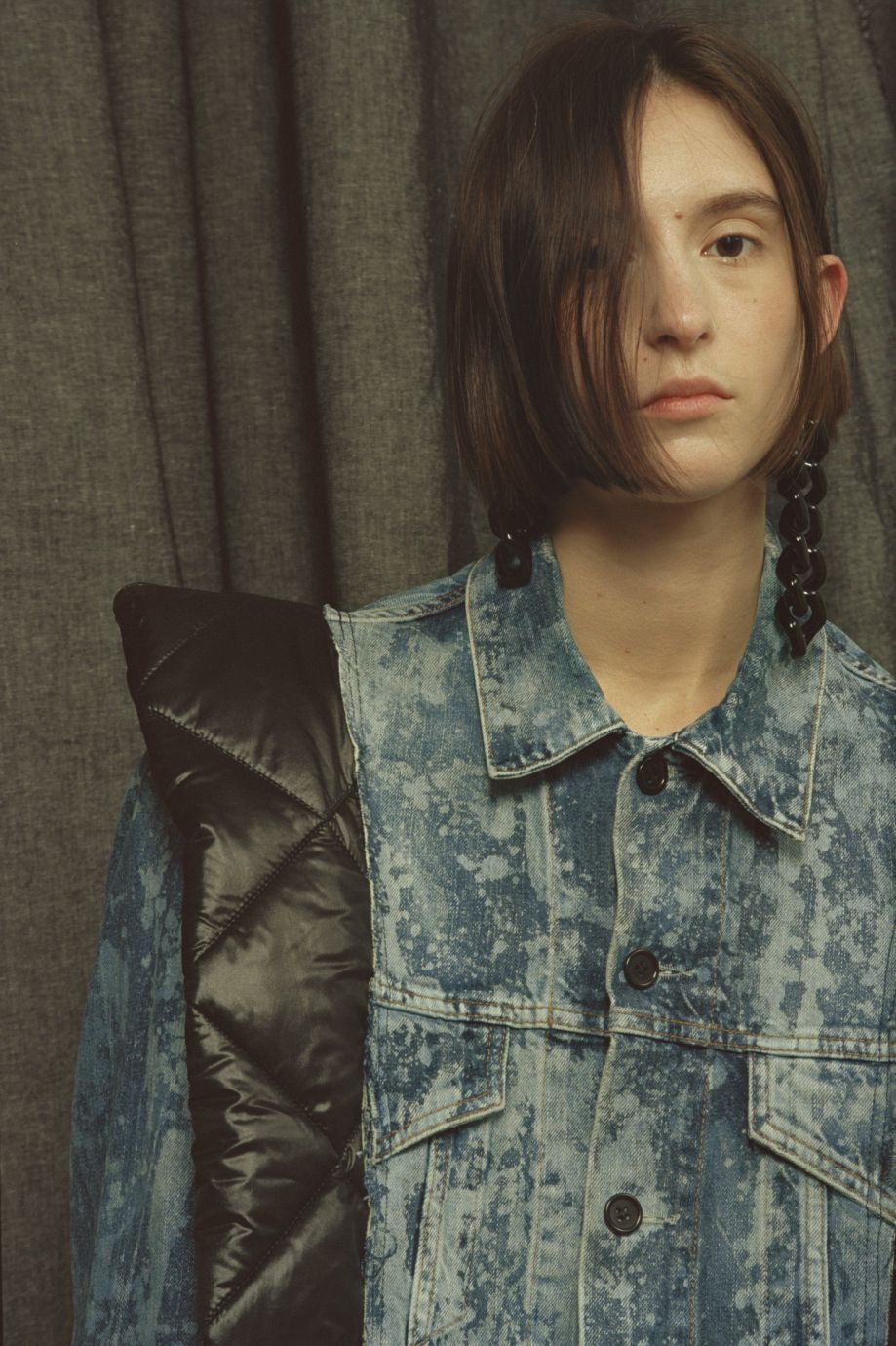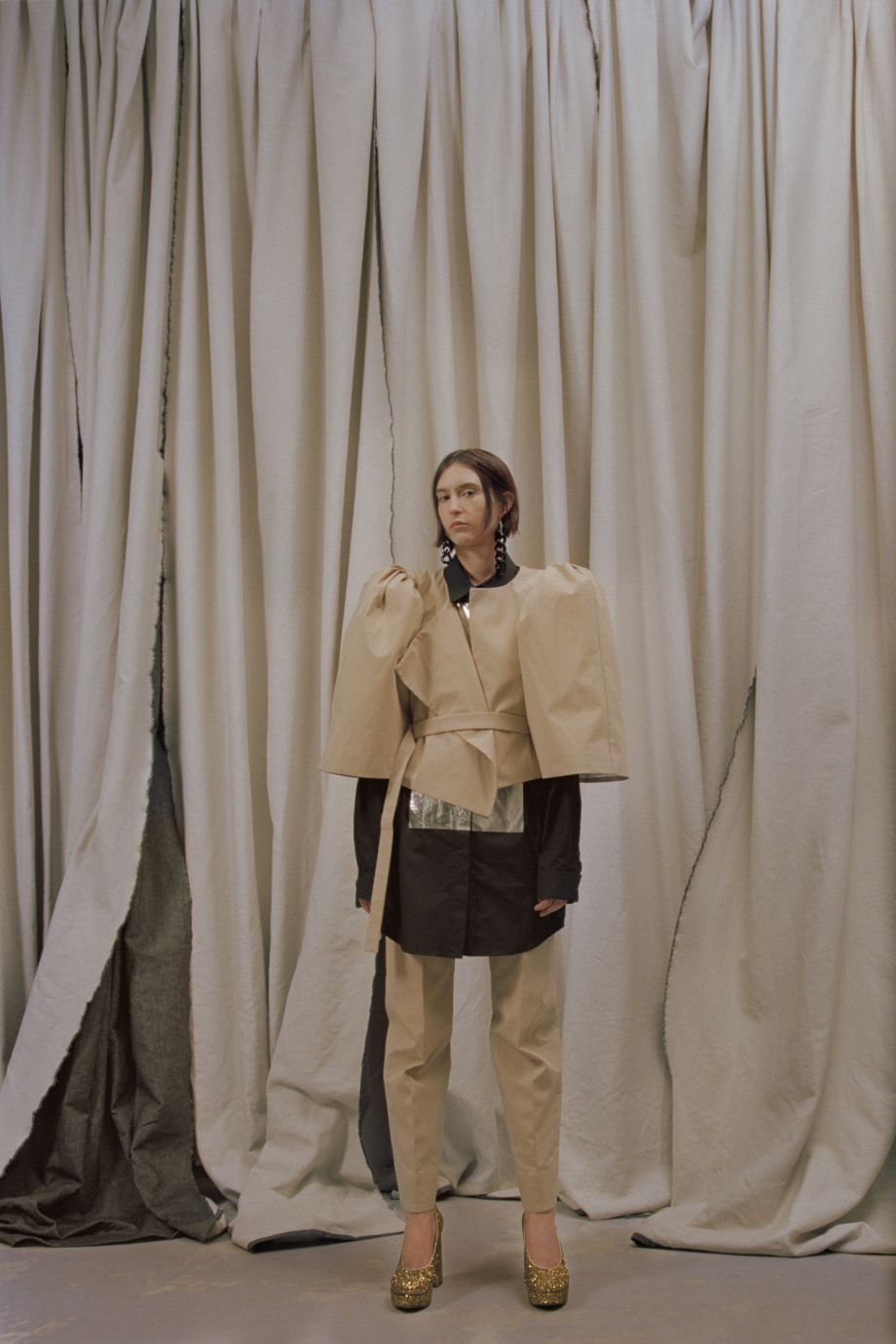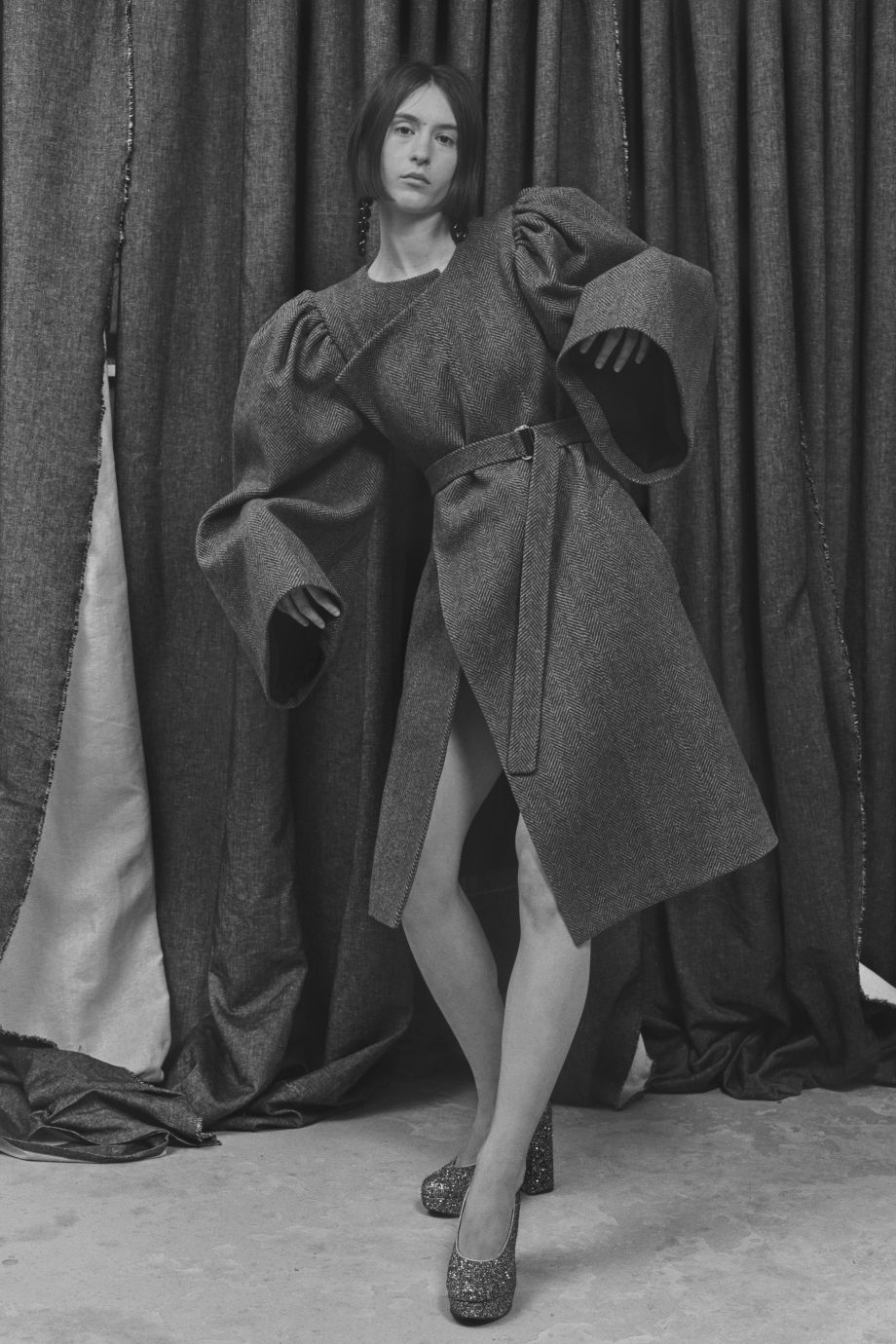Those who have been in the field for a while know that mistakes are rarely fatal, and that closed doors often lead to open windows. Thus, growing up means calming down, and finding security in your own voice. Youth, on the other hand, profits off the endless energy that comes with naive enthusiasm, a fuel that doesn’t burn out.In an industry that never talks about age, excitement and experience can become polar opposites. At the head of his 17-year-old namesake label, womenswear designer Lutz Huelle finds himself effortlessly combining the two. With almost two decades of experience – having worked at Martin Margiela after graduating at CSM – the Paris-based German is well aware of the ups and downs of running your own company.It was five seasons ago, however, that he discover the key to a balanced design process: dare to repeat yourself. Ever since, final collection line-ups are no longer taken down when the new season starts, but proudly guard his office walls, overlooking and guiding the birth of new ideas. The designer known for his deconstruction of vestimentary rules and his reappropriation of iconic garments, has found a way to question, not just fashion in general, but even clothes of his own. With the wisdom of an experienced mentor and the passionate energy of a fearless student, Lutz discussed education, the importance of critique and his life-changing years in London.
In fashion you’re always supposed to reinvent yourself and repetition is seen as something negative. However, true artist have a signature of their own. How do you balance this ?
That’s an interesting question. One of the things I did wrong in the past was moving on too quickly. Once something was done, I felt like I had to go forward. When you work on a collection for six months, it’s so close to you. I come into the office and see it on the wall, every single day. I get bored easily with things, which is why I felt like doing something different after each season. But then you forget that customers don’t perceive it that way at all. They only see it once every six months, and sometimes they only have 2-3 minutes to see what’s in front of them. They need more time to get used to things. It’s something I realised a few season ago – you don’t need to move on that quickly. You can allow yourself to say something is still valid after one season.
In a way, you always work for the same kind of person. You always dress the same type of client. So it stays within the same world, within the same taste. So now I think – I still like this garment, I’ll just tweak it slightly. Since I’ve been doing that, five seasons ago, people are reacting in such a strong way. Suddenly they say it’s signature pieces, and something they recognise you for. It’s true, but I never realised it, because my mind isn’t that commercial. If you think in a commercial way you understand that you need to hammer a message down for people to understand. I never got that, I always went on. It never occurred to me that you need to think about these things.
Now, I keep the collections on the wall, and I make sure that everything I do comes from what I did before, which is such a nice way of doing things. I’ll look at my collection and think – that was a nice idea but it wasn’t done in the perfect way, or maybe you could’ve done it in a different way. I tweak my own work slightly. Instead of continuously moving on to the next idea, I develop something further. It avoids staying on the surface of ideas. It also makes the white wall so much less daunting.
It’s interesting that the reactions have been so positive. Did you ever feel pressured to do something new each season?
It’s the moment. People are looking for security. One of the things that made me decide I wanted to work this way, was that I needed to hold to things that give me joy and make me feel secure. It’s this thing of not jumping into cold water each season. People need to see things they’ve liked before. Maybe because times are so insecure. At other moments people might feel like it doesn’t move on enough. But to be honest with you, at the end of the day, the only thing that matters is that people will actually wear these clothes. That’s the one thing that makes my work relevant. Anybody can have an opinion, but what is really important is that you see someone wearing your clothes in the street and that this person is looking good. That’s all that counts. People can say it’s repetitive, but as long as somebody out there likes it and wears it… That’s my job in the end.
“At the end of the day, the only thing that matters is that people will actually wear these clothes.”
The bomber with wool panels for example, you did that multiple seasons.
Something else I never did before, was putting the exact same garment in the show again. I thought – fuck this! David asked me if I was sure, and I just said – I don’t care. Which was such a liberating moment! No one said anything, people loved it. It’s been positive.
The one thing I see consistently change is colour.
I always love neutrals, with really strong primary colours. One of the things I did when I first started showing again, is that I wanted to go back to the beginning and see what I liked about the first collections. I love the combination of yellow and beige for example, or pink and grey. Those strange mixtures of masculine and feminine. Because the shows went so well, I became more and more daring. When things are positive, you’re less careful. You just do it because you like it. I wanted to do something with fur, in yellow, and a washed out denim. The first reaction here was – that’s impossible! But it felt so right to me. Five years ago I would’ve doubted, can I do this? If you work in a positive environment, it’s easier to just go with it. I can actually see my regained self-confidence. It grows and grows and grows. Everything takes so much more time when you doubt and think about what other people think. I’ve always been a worrier, I can’t not care. I’m more careful, and I question myself 10 times before I do anything. But it’s been so liberating to let go of that. When you’ve been designing for a while, it’s hard to get back to that innocence of being super enthusiastic and positive. I didn’t think that was even possible, of getting back to that state of pure joy.
Has it happened that collections work well commercially, and that the client is happy, but that the press and critiques don’t like it, or vice versa?
It’s almost a rule: if a collection is liked by the press, it won’t sell well. [laughs] We always worry when people like the show. Usually, the press likes strong collections, but then the final customer won’t buy as much, which is natural. Weirdly enough, the last few seasons this hasn’t been the case. People loved the shows and we’ve sold well, so there has been a general consensus that it’s working. But there have been shows that I loved, but that didn’t sell. Or shows I didn’t really like that sold really well. It’s always a different reality on a catwalk and in a show. One thing I’ve always been criticised for, is that the shows weren’t extreme or strong enough. But I’ve always wanted to dress people, I never wanted to dress models.
“It’s almost a rule: if a collection is liked by the press, it won’t sell well.”
How do you design for this woman?
I always ask myself, what will somebody look like in this piece of clothing? I always think of people I know, friends. Would she wear this coat? How will she look wearing this dress? So it’s always a question of how people will look in reality, instead of how they’ll look in a show. I stopped doing shows for three seasons, because I needed to get back to myself. Fashion is such a continuous stress, I just felt like I needed I break. I needed to stop. There was a difficult moment when the crisis happened. In general, people weren’t buying clothes anymore. It was a dangerous moment, and I thought – let’s stop for a moment and see what happens. What’s funny is that we were worried we might sell less, but people didn’t mind at all – show or no show. It just meant we weren’t that visible in the press anymore. But, the clients didn’t mind. We were always under the radar, yet we always sold well in the shops. People don’t buy us because we’re a name, but because they like the clothes. Which is what I always wanted, that people like these clothes and wear them. Now that people like these clothes and ask for the name, it’s so nice! But that’s just on top.
Talking about brand recognition, your logo has become more visible in recent collections as well.
That logo is a really funny story. When I just started, the only thing that was repeated on each garment was that logo, but then we had a copyright issue. We couldn’t use the name Lutz on its own anymore, another company bought it. But out of something negative always comes something positive. So we decided to use the whole name and see what happens. When we started showing again, it felt like a new start, and I thought – I’ll go back to my roots and look at what I did in the beginning, which was that logo amongst other things. As we’re not using the name “Lutz” anymore, besides the logo which isn’t recognisable, it’s not a problem. It’s almost like a little inside joke between David and me.
David Ballu, did you start the company with him?
David organises everything around the collection: the sales, the show,… In a way he’s the boss, he runs the company. Whenever I have I ideas, whenever I want to push the company somewhere, I run them by him. It’s so important, I can’t work in a vacuum. You always have to see, or at least I always have to ask – what do you think of this? We won’t always have the same opinion, but it’s good to go back and forth between things. We also have different cultures, he’s French, I’m German, he has a certain way of seeing women and I have a different view of femininity. So it’s interesting to bounce ideas back and forth.
Where did you meet?
We met in Paris. I did a placement at Margiela while I was at Saint Martins, and they asked if I would like to work for them once college would be finished, which I did. I went straight after college to work here, and I met David six months later. He was still working at Rochas and we became friends. When I left Margiela, I wanted to go back to London, so I started teaching at Saint Martins. David wanted to leave Rochas, and I thought – what will I do with my life? So we decided to try something together. And that’s what happened. It went like that. It wasn’t really planned, weirdly enough.

Why did you decide to base your company in Paris?
Because David always lived here. And I had this very romantic idea of London as a student, so I was worried it might not be the same. You can never go back for sentimental reasons, that never works out. I thought – I’m here now, this is obviously where I’m supposed to be so I’m going to stay. It took me years to get over that feeling of wanting to live in London, because I was so happy there. I felt so welcome there. The way they dress… it’s so open. When you go to corner shops and people are so friendly to you. I never thought the British were cold or unfriendly, I always thought they were hugely affectionate.
You mentioned in previous interviews how London was this creative bubble, but Paris wasn’t that open. That seems to be shifting as well.
Absolutely. It’s funny because, for the first time ever now, I feel good in Paris. It’s taken me such a long time. Maybe because it’s a new generation, people are more open. It’s not so focussed on being Parisian anymore. The French travel so much, they go to London, to Berlin. There’s less navel-gazing. Paris is an amazing city, but it’s not the only city in the world.
It’s funny how a city’s strength comes from its connection to other cities.
It’s so important, that feeling of tolerance. Going out and realising there isn’t just your own culture, but other cultures that are an opportunity for positivity.
While we’re comparing two cities… You teach at both at Central Saint Martins and La Chambre Syndical in Paris. Is the education different?
Not so much anymore. Maybe because Paris has opened up. I never worked in French schools before, so I don’t want to generalise, but I feel like they’re super open now. La Chambre is super welcoming and open to change. They’re making a huge effort and it really pays off. I don’t adapt my teaching techniques to different colleges, but I can feel that the way the schools work is similar. Obviously, I have sentimental links to CSM, so it’s different because I feel so at home there. It changed my life in so many ways. I feel huge gratitude to that place.
“I became really interested in fashion, and the way you could change through the way you dressed. That was such a pivotal moment.”
Did you go to CSM after high school?
I left high school, then I went to Hamburg for two years, not doing anything, just going out all the time. Which was very nice, but also very dangerous, because you just start sleeping all day. I thought – I need to actually do something with my life. So I decided to move to London, without actually having a place at CSM. It was a dream to live in London, I’ve always loved England. I went on language courses there while I was still in high school, so I had been going there every year since I was fourteen or fifteen. I always used to go to Brighton and stay with the same family. I had such strong links to English pop culture and music.
Then why did you decide to study fashion design?
It wasn’t so much about fashion design in the beginning. What I really liked was popular culture, like music. While others were playing football outside, I was listening to the radio inside. I was so obsessed with music. Fashion was just another part of that. You listen to music all the time, and you look at popstars and the way they dress. There was this whole package of popular culture. Then I became really interested in fashion and what clothes could do to you. The way you could change through the way you dressed. The way you expressed yourself by dressing differently. That was such a pivotal moment.
I was always fairly well behaved in Germany, so when I moved to London I went mad for a while, just because everything seemed possible. I had my hair cut into a Mohican. It’s just a silly haircut, but I felt like a different person. I realised you could do anything to yourself visually, and whatever you do to yourself visually will also change yourself as a person. That feeling was so strong, to say, I can be anybody, anything. There’s no limits to how you can be, and you can express that by the way you look. That got me interested in fashion. Also, playing with those vestimentary codes: what does a trench say about you, what does a bomber jacket say about you? That’s the one thing that keeps me going, and it never stops.
Everything you’re saying is so recognisable. This play on identity, fooling other people about who you are, or revealing it completely.
It’s funny how people can make assumptions about you and the way you look. It can be so wrong. Fascinating. Once you realise that, you can take it and use it. Growing up, I was always very skinny, and fairly small. Very different from what German men are supposed to be. People look at you and think you’re one thing, but actually you’re a completely different person inside.
Fashion creates circles by expressing who you belong to, or want to belong to.
Fashion shows straight away – I’m not this person and I don’t belong to that person, I don’t agree with what they say. Without speaking a single word.
You mentioned these iconic pieces – like the bomber – which you then deconstruct in your work. Is that something you learned at Margiela?
I felt attracted to his work because it spoke to me in so many ways. I thought – this is a person who thinks exactly like I do. It felt so familiar to me. What was really great about Margiela, was that it wasn’t about a luxury product in that sense. It felt like it was also for people who weren’t part of the elite. I felt like it spoke to people on a democratic level, it was for everybody. In a way, fashion in the 80s was very much about elitism and a certain income bracket, which to me wasn’t that interesting. That doesn’t mean I don’t like beautiful things or that I don’t like the idea of luxurious clothes, obviously they’re wonderful and a pleasure to deal with, but that wasn’t what made me want to be a designer. I liked the democratic approach, taking an old pair of jeans and altering it slightly so that it looks amazing. You don’t need anything in order to look good. It’s not a question of who you are socially, it’s a question of taste.
Do you try to keep your prices democratic as well?
When you’re a small company, your overheads are very high. The more you sell, the cheaper it gets obviously. Because our production is fairly small, prices stay high. Which is annoying, not everyone can afford it. It is frustrating to know that some people might like to buy these clothes and would look amazing in it, but can’t afford it. On the other hand, if you choose really cheap fabrics, it doesn’t work either. It’s a complicated balance. Obviously, we try to keep prices low, but we’re still a company and we have to make sure we don’t have financial problems. There was a point where I said – a jacket should never cost more than this amount. But it became really dangerous for us, because the marges went down so much. Owning a company in France is already so expensive. I have to find the balance between being able to survive, and finding price points that are acceptable for loads of different people.

